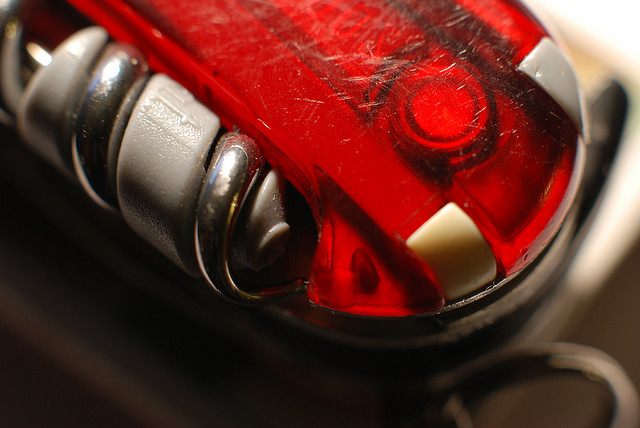The Simple, Elegant History of the Swiss Army Knife

An “EvoGrip 18” Swiss Army Knife. (Photo: D-M Commons/WikiCommons CC BY-SA 3.0)
A version of this post originally appeared on the Tedium newsletter.
The Volkswagen Golf is “the Swiss army knife of transport.” Lavender is “the Swiss army knife of essential oils.” There’s a “Swiss army knife of barrettes,” and a frankly awesome “Swiss army knife of jackets.” A single object with numerous uses is an incredibly powerful idea, and the Swiss army knife owns the category.
But the knife’s usefulness isn’t a marketing ploy; it’s boring, obvious, and practical. Switzerland’s army needed a way to ensure that officers on the hunt could repair their guns, open their canned food, and cut stuff as needed.
The idea for the knives came about in the 1880s, when the Swiss military decided that it needed to give soldiers a simple, portable tool. At first, no suitable tool-producing factories existed in the country, so they had to outsource the work to Germany, but eventually a talented Swiss inventor, Karl Elsener, stepped up and manufactured something that fit the bill.
In 1891, Elsener’s tool was handed to military officers. It was popular, though some complained about it, so he went back to his shop and made it even better, adding a corkscrew to the mix. Since then, the device has largely remained structurally the same.

Karl Elsener. (Photo: Public Domain/WikiCommons)
The company didn’t have a name at first, but Elsener, heartbroken over the death of his mother Victoria, named it after her in 1909. In 1921, the firm began using stainless steel in its knives, and the company came to be known as Victorinox, “inox” being a French term for stainless steel.
The knives didn’t gain their international prominence until the 1940s, when World War II exposed the devices to large audiences of Americans who struggled to say the original name, Schweizer Offiziersmesser. “Swiss army knife,” the literal translation, was easier to handle.

Modell 1890, the first Swiss Soldier Knife produced by Wester & Co. Solingen. (Photo: Cutrofiano/WikiCommons CC BY-SA 3.0)
Knives might seem like a curious export for such a famously neutral country. But the Swiss army is actually fairly large, as 260 days of military service is compulsory for young men there; those who object to military service can choose 390 days of civil service instead. The army is generally focused on peacekeeping and defense missions, and soldiers can request not to use guns. They are, however, given the namesake pocket knives (specifically, this model), which aren’t considered weapons.
Victorinox can accurately call itself an original producer of Swiss army knives, but it did have a longtime competitor called Wenger. The Swiss army split its contract for the knives between the two companies in 1909.

Soldatenmesser 08, the model of the knife issued to the Swiss Armed Forces since 2008. (Photo: Francis Flinch/WikiCommons CC BY-SA 3.0)
But recent troubles in the industry—particularly the post-9/11 airport climate, which made it difficult to take small knives onto planes—damaged Wenger’s business to the point that Victorinox had to step in to buy its competitor in 2005.
Those troubles briefly knocked the wind out of Victorinox, too. The knife was shorthand for Swiss culture, with a sizable presence in the travel and luggage industries, and was a constant seller at duty-free stores prior to the attacks.
“Our company has never been as hard-hit as it was by the Sept. 11, 2001, terror attacks in New York and Washington,” CEO Carl Elsener Jr. noted in a 2013 press release. “We lost over 40 percent of our business. Airports sent vast quantities of the knife back to us.”

A close-up of the corkscrew mechanism, which appeared on the Officer’s Knife model in 1897. (Photo: Henner Zeller)
But Victorinox has not had to lay off a single employee. The brand has remain solvent and family-owned throughout its history, diversifying its offerings repeatedly in recent years. On top of luggage, the company known for making tiny portable knives now makes watches and fragrances. It’s also gone in quite a few weird directions. Among those:
Chocolate candy bars. Victorinox makes hazelnut chocolates wrapped like Swiss army knives, because clearly Switzerland needed another kind of chocolate to compete with Toblerone.
USB drives. Victorinox has in recent years embraced the need for everything to plug into a computer, and its Victorinox@Work line of USB drive Swiss army knives does the trick.
MP3 players. Hold on to your iPod Nanos, because Victorinox once made a Swiss army knife with a built-in MP3 player.
Fancy executive blades. For the business executive who wants to have basically everything on his desk but never use it, the Victorinox Swiss Army SwissChamp XAVT includes 80 separate functions, including a ball point pen. You know, just in case there isn’t another pen around.
141-function knives. Good luck trying to find one, but Wenger has in the past sold a two-pound, 141-function Swiss Army Knife, a device that’s probably way too large to fit into your pocket but includes a cupped cigar cutter, a ruler, and an awl. It costs more than a Macbook, but it probably does a lot more, too.

Victorinox Swiss Army SwissChamp XAVT. (Photo: Dave Taylor/WikiCommons CC BY 2.0)
When people talk about Swiss product design, it’s generally in reference to the country’s long legacy of fine watches. But nothing gets good design into people’s hands better than a product that can whittle a stick, scale a fish, and clean one’s fingernails.
In a day and age when so many companies are trying to strike the perfect balance between innovation and necessity, there’s a lot to admire about the Swiss army knife, which turned a toolbox full of hardware into something so small you might even forget you’re carrying it.
It takes a lot of work to build something so simple.
 A version of this post originally appeared on Tedium, a twice-weekly newsletter that hunts for the end of the long tail
A version of this post originally appeared on Tedium, a twice-weekly newsletter that hunts for the end of the long tail












Follow us on Twitter to get the latest on the world's hidden wonders.
Like us on Facebook to get the latest on the world's hidden wonders.
Follow us on Twitter Like us on Facebook